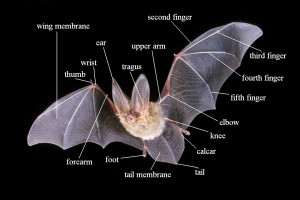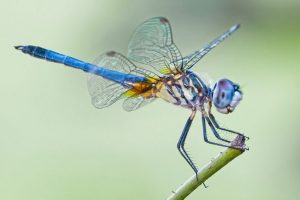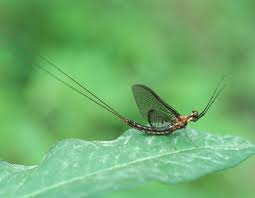It’s All About the Bats!
 Wonderful winged creatures, bats are pretty mysterious because of their physiology and their lifestyle.
Wonderful winged creatures, bats are pretty mysterious because of their physiology and their lifestyle.
Even though they fly, bats are mammals; they are warm-blooded creatures who have live births (rather than laying eggs like a bird) and nurse their young. Look closely at the wing, and you will see an “arm” and long bony “fingers” resembling the human hand! Their wing tissue is very thin and maneuverable in the air.
Bats do have eyesight, but it is not as refined as human eyesight. Since bats hunt for food at night, and some of them live in dark caves, they need another different sense to get around – their ears! Big ears allow the bat to use echolocation by sounding off and receiving reverberations back to the bat’s ears. These reverberations are sending messages to the bat about where it needs to fly, objects it needs to avoid, and where its food is. Bats fly at night, often catching food “on the wing” (which means their food is flying as well!), so echolocation allows them to maneuver in the dark.
In Missouri, all bats hibernate in winter – some in the forest and some in caves. This is because Missouri bats are insect-eaters, and during the cold winter months, there are no insects available to bats. This is when bats get very still and their blood pressure and heart rate slows down, so that they don’t use too much of their body stores by moving about. Learn more about bat hibernation.
A fun way to get to know more about bats is an annual event we are a part of. Bat Fest is held each year and is co-hosted by The World Bird Sanctuary and Onondaga Cave State Park.
Curious about White Nose Syndrome & what that Means for our Bats?
Called White-Nose Syndrome (WNS) because of the tell-tale sign of white fungus Geomyces destructans gathered around the bat’s nose, the fungus appears to disrupt the normal patterns of hibernation, causing bats to arouse too frequently from torpor (temporary hibernation) and starve to death through excessive activity. The symptoms associated with WNS include loss of body fat, unusual winter behavior (including flying), damage and scarring of the wing membranes, and death.
WNS started in the United States in a cave in New York and has since been spreading from East to West, now in Missouri, Arkansas, northern Texas, and northward in Minnesota. In 2017, WNS jumped to a cave in Washington State. See a current WNS range map here.
Onondaga Cave State Park has had bats with White Nose Fungus since 2013, and the bat population in this cave has been dropping precipitously, according to the Park’s annual bat surveys. It is hard to know how our cave bats will ultimately be affected, but we are currently having large losses of cave bats, particularly the Little Brown Bat and the Tricolor (prior name Eastern Pipistrelle) Bat. Some bat species that were already endangered, like the Ozark Big-Eared Bat, may not survive. Scientists are currently working on possible solutions to this fungus, solutions we will follow up on here.
What Can We Do?
While we know that WNS is spread primarily from bat to bat, there are still things we can do to help. Please learn about this problem, be respectful of caves that are closed, and wear different shoes, clothing, backpacks, etc. when going to different caves, and use alcohol swabs to wipe clean your eyeglasses, watch, cameras. For more info read through the FAQs on White Nose Syndrome.
We can also help the bats by encouraging more of their natural food, which is — BUGS!  Bats benefit from food diversity the same as we do! Some things we can do:
Bats benefit from food diversity the same as we do! Some things we can do:
- Build or buy a bat house, hang it up, and watch for signs of bat occupation
- Grow a native bat garden. Encouraging pollinator insects is great for the environment, and bats like them too!
- Join a Stream Team. Clean streams allow for greater insect diversity. It is really cool to sit on a river bank and watch the bats swoop down into the later evening mist to catch some newly transformed macroinvertebrates!
Coming Up! Some of the bugs that Missouri bats love to eat!


